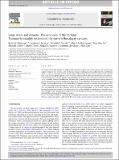Large rivers and orogens : The evolution of the Yarlung Tsangpo–Irrawaddy system and the eastern Himalayan syntaxis
Abstract
The eastern Himalayan syntaxis has experienced some of the highest rates of deformation and erosion in the orogen during the Late Cenozoic, and the Yarlung Tsangpo, Brahmaputra, Irrawaddy, Salween, and Mekong rivers are the key erosional systems in that region. The Yarlung Tsangpo drains southern Tibet and the deep Siang River gorge through the eastern Himalayan syntaxis before joining the Brahmaputra in northeastern India. It has been proposed that the Yarlung Tsangpo drained into other large rivers of southern Asia, such as the Irrawaddy, Salween and Red River. We have used uranium/lead dating and hafnium measurements of detrital zircons from Cenozoic sedimentary deposits in Central Myanmar to demonstrate that the Yarlung Tsangpo formerly drained into the Irrawaddy River in Myanmar through the eastern syntaxis, and that this ancient river system was established by (at least) the Middle–Late Eocene. The Yarlung Tsangpo–Irrawaddy river disconnected in the Early Miocene driven by increased deformation in the eastern syntaxis and headward erosion by tributaries of the Brahmaputra. Our results highlight the significance of the sedimentary record of large orogen-parallel rivers and provide key chronological constraints on landscape evolution during the Early Miocene phase of the Himalayan orogeny.
Citation
Robinson , R A J , Brezina , C A , Parrish , R , Horstwood , M , Win Oo , N , Bird , M I , Thein , M , Walters , A , Oliver , G J H & Zaw , K 2014 , ' Large rivers and orogens : The evolution of the Yarlung Tsangpo–Irrawaddy system and the eastern Himalayan syntaxis ' , Gondwana Research , vol. 25 , no. 1 , pp. 112-121 . https://doi.org/10.1016/j.gr.2013.07.002
Publication
Gondwana Research
Status
Peer reviewed
ISSN
1342-937XType
Journal article
Description
This work was supported by a Natural Environmental Research Council Isotope Geosciences Laboratory award (NIGL IP/943/110).Collections
Items in the St Andrews Research Repository are protected by copyright, with all rights reserved, unless otherwise indicated.

